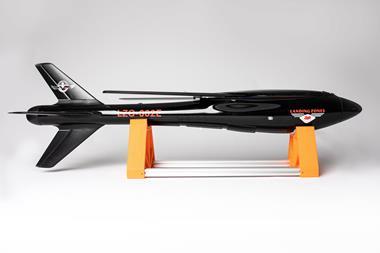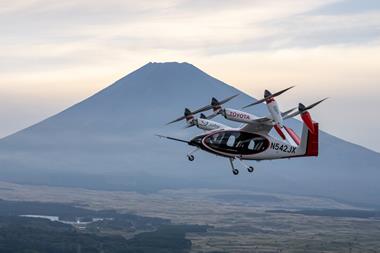General Atomics Aeronautical Systems has secured an additional $9 million in funding from the US Air Force (USAF) to continue development of the company’s prototype XQ-67 Off-Board Sensing Station jet.
The San Diego-based manufacturer of uncrewed aircraft received the Air Force Research Laboratory (AFRL) contract on 1 June, bringing the Pentagon’s total investment in the project to nearly $68 million.
General Atomics first revealed the existence of the XQ-67 in February, with the type making its first flight later that month. The single-engined jet was remotely piloted for that sortie, but the air force says it does have the ability to fly autonomously.
The service on 26 June released the first video from that maiden flight, which took place from a General Atomics facility near Palmdale, California.
The AFRL describes the XQ-67 as the first example of a “second-generation of autonomous collaborative programmes”, one that builds on technology developed for the Kratos XQ-58 Valkyrie autonomous jet.

Based on the video and images released by the USAF, one notable difference is that the XQ-67 has conventional landing gear, whereas the Valkyrie is launched with a rocket booster and lands with parachutes.
The air force’s ultimate objective is to produce low-cost, autonomous aircraft, which can be deployed in large numbers to support crewed platforms with a range of capabilities, potentially including sensor support, lethal strike, electronic warfare and air-to-air refuelling.
The AFRL says that the XQ-67A provides a common chassis or “genus”, allowing for a standardisation of airframes, but with the ability to quickly integrate different mission systems.
“This approach will help save time and money by leveraging standard substructures and subsystems, similar to how the automotive industry builds a product line,” Doug Meador of the AFRL aerospace systems directorate said in February.
“From there, the genus can be built upon for other aircraft – similar to that of a vehicle frame – with the possibility of adding different aircraft kits to the frame,” he added.
General Atomics and the USAF designed, built and flew the XQ-67 in just over two years, according to the AFRL. The experimental aircraft is known to have completed at least three sorties.
The company is now a finalist for a separate USAF programme to develop an operational uncrewed fighter – dubbed a Collaborative Combat Aircraft (CCA). General Atomics and California start-up Anduril were selected as finalists for the first iteration of CCA development, beating out aerospace heavyweights Boeing, Lockheed Martin and Northrop Grumman.
Little is known about the CCA designs, other than they are intended to pair with the highly-classified Next Generation Air Dominance sixth-generation fighter aircraft currently under development.


















































